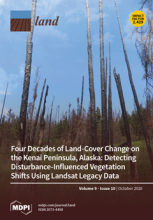Land Library
Welcome to the Land Portal Library. Explore our vast collection of open-access resources (over 74,000) including reports, journal articles, research papers, peer-reviewed publications, legal documents, videos and much more.
/ library resources
Showing items 1 through 9 of 41.Land degradation has become one of the major global environmental problems threatening human well-being. Whether degraded land can be restored has a profound effect on the achievement of the 2030 UN Sustainable Development Goals.
This study investigates the main threats related to environmental degradation that affect Amazonian Indigenous Lands (ILs). Through a cluster analysis, we group ILs according to the set of common environmental threats that occur within and outside their limits.
It is crucial to pay close attention to the ecological security in land consolidation and utilization of coastal tidal areas and make an appropriate zoning scheme to meet the characteristics of its particular landscape.
Farmland fragmentation and farmland consolidation are two sides of the same coin paradoxically viewed as farmland management tools.
Land degradation, especially soil erosion, is a societal issue that affects vineyards worldwide, but there are no current investigations that inform specifically about soil erosion rates in Chinese vineyards.
In many countries of the world, rural areas are characterized by a defective spatial structure of agricultural land. The most frequent defects are large fragmentation and distribution of farmland. The fragmentation of land has been an issue widely described by many authors throughout the world.
Due to industrial civilization, the decline of the countryside has become a global phenomenon. Spain is a good example that reflects this issue in the rural areas of the European Union because more than half of all municipalities in the country are at risk of extinction.
Achieving change to address soil erosion has been a global yet elusive goal for decades. Efforts to implement effective solutions have often fallen short due to a lack of sustained, context-appropriate and multi-disciplinary engagement with the problem.
A framework was developed to elucidate (1) the drivers of land degradation, (2) pressures, (3) local impacts and vulnerabilities and (4) adaptation strategies.




